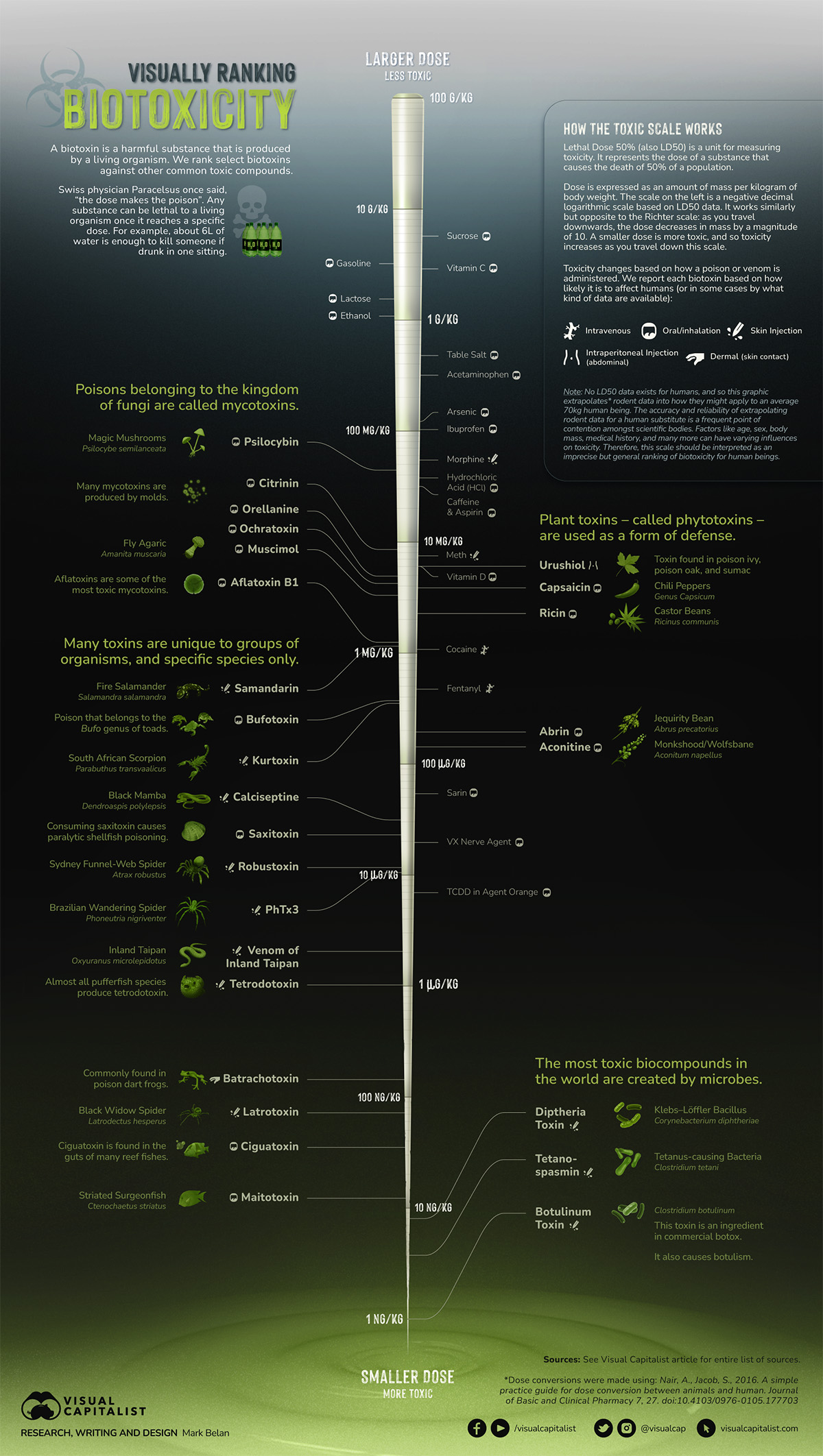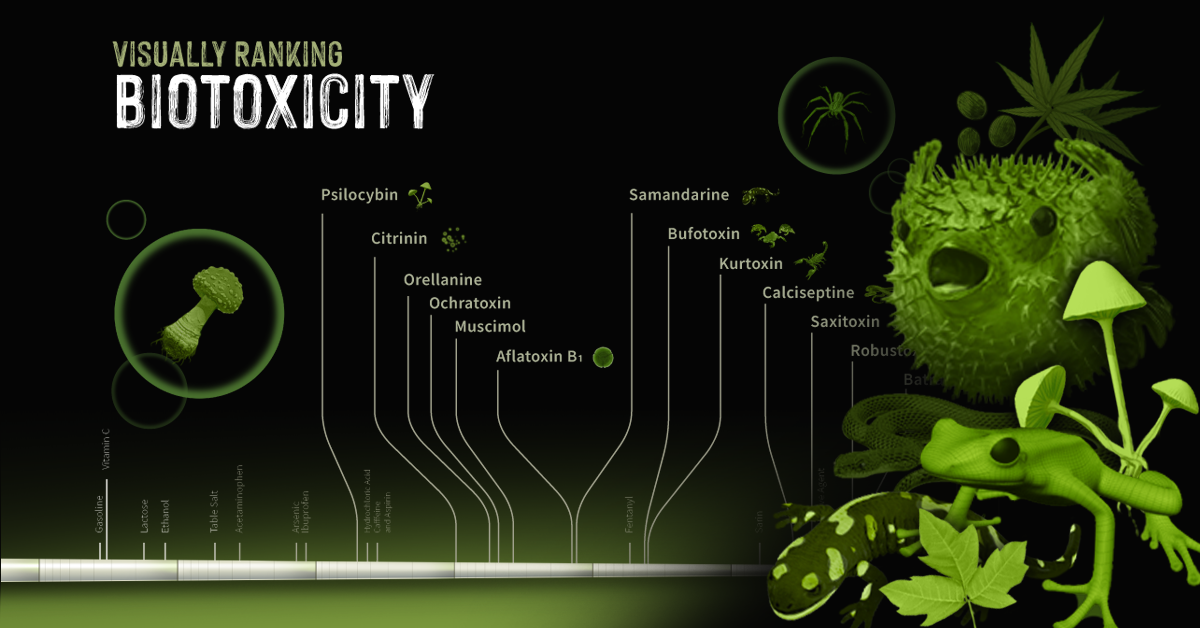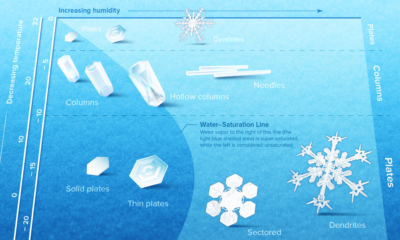Misc
Ranked: Biotoxins in Nature, by Lethal Dose
View the full-size version of this infographic
Biotoxins: Poisons of the Natural World
Biotoxins are harmful substances that come from living organisms.
They can take many forms, from the venom of a snake or spider to the neurotoxins produced by certain types of algae or microbes.
In the infographic above, we look at some common biotoxins in the natural world and rank them based on how deadly they are to an average 70 kg (154 lb) human being.
Ranking Biotoxins on a Toxic Scale
A basic concept in toxicology is that “only the dose makes the poison”. Everyday harmless substances like water have the potential to be lethal when consumed in large enough concentrations. Measuring a lethal dosage is very difficult.
First, living things are complex: factors like size, diet, biochemistry, and genetics vary across species. This makes it difficult to qualify toxicity in a universal way.
Second, individual factors like age or sex can also affect how deadly a substance is. This is why children have different doses for medications than adults.
Third, how a poison is taken into the body (orally, intravenously, dermally, etc.) can also impact its deadliness.
As a result, there are many ways to measure and rank toxicity, depending on what substance or organism is under investigation. Median lethal dose (LD50) is one common way for measuring toxicity. LD50 is the dose of a substance that kills 50% of a test population of animals. It is commonly reported as mass of substance per unit of body weight (mg/kg or g/kg). In the graphic above, we curate LD50 data of some select biotoxins found in nature and present them on a scale of logarithmic LD50 values.
What’s surprising is just how potent some toxins can be.
Bits and Bites about Biotoxins
While one would think that biotoxins are avoided at all costs by humans, the reality is more complicated. Here are some interesting facts about biotoxins present in nature, and our unusual relationships with the organisms that create them:
1. Fungi and molds make poisons called mycotoxins
Mycotoxins are a global problem. They affect crops from many countries, and can cause significant economic losses for farmers and food producers.
2. Phytotoxins can defend plants…and attack cancer
Plants use phytotoxins to defend themselves other organisms, like humans. Urushiol, for example, is the main toxic component in the leaves of poison ivy, poison oak, and sumac. But the Pacific yew tree produces taxol that’s valuable in chemotherapy treatments.
3. Fire salamander toxin is an ingredient in Slovenian whisky
Though not widely available, some whisky makers in Slovenia use samandarine from the fire salamander to create a psychedelic alcohol.
4. Ciguatoxins exist in the guts of reef fish
Very unique species of bacteria living in the digestive tract of reef fishes make ciguatoxin. They transmit this poison to other organisms when the host fish is eaten.
5. Pufferfish are deadly, but also delicious
Pufferfish contain tetrodotoxin, a potent neurotoxin in their ovaries, liver, and skin called tetrodotoxin. Despite being a delicacy in many countries around the world, it has a lot of strict regulations because of its ability to kill people. In Japan, for example, only specially licensed chefs can prepare pufferfish for consumption.
6. Batrachotoxin is lethal to the touch
The skin of some poison dart frogs secretes a deadly substance called batrachotoxin. It is so potent that simply touching the poison can be fatal. Indigenous people of Central and South America used batrachotoxin to poison the tips of hunting weapons for centuries.
7. Botox contains the most deadly biotoxin known
Commercial botox uses an extremely small amount of biotoxin from a microbe called Clostridium botulinum. It paralyzes the muscles, preventing contraction (i.e. wrinkling). It is the deadliest known biotoxin on Earth. One gram of botulinum toxin can kill up to one million people.
Caveats of Measuring and Reporting Biotoxicity
While we use LD50 data to rank biotoxicity, it isn’t an exact science. There is room for improvement.
For starters, no LD50 data exists for humans. That means data from other organisms has to be converted to apply to humans. There is a lot of contention amongst scientific communities about how accurate this is.
There has also been an increasing effort to move to new methods of measuring toxicity that are not harmful to animals. Several countries, including the UK, have taken steps to ban the oral LD50, and the Organisation for Economic Co-operation and Development (OECD) abolished the requirement for the oral test in 2001.
Now, new ways of evaluating toxicity are under investigation, like cell-based screening methods.
Correction: Water was mislabeled on a previous version of the infographic. Full sources here
VC+
VC+: Get Our Key Takeaways From the IMF’s World Economic Outlook
A sneak preview of the exclusive VC+ Special Dispatch—your shortcut to understanding IMF’s World Economic Outlook report.

Have you read IMF’s latest World Economic Outlook yet? At a daunting 202 pages, we don’t blame you if it’s still on your to-do list.
But don’t worry, you don’t need to read the whole April release, because we’ve already done the hard work for you.
To save you time and effort, the Visual Capitalist team has compiled a visual analysis of everything you need to know from the report—and our upcoming VC+ Special Dispatch will be available exclusively to VC+ members on Thursday, April 25th.
If you’re not already subscribed to VC+, make sure you sign up now to receive the full analysis of the IMF report, and more (we release similar deep dives every week).
For now, here’s what VC+ members can expect to receive.
Your Shortcut to Understanding IMF’s World Economic Outlook
With long and short-term growth prospects declining for many countries around the world, this Special Dispatch offers a visual analysis of the key figures and takeaways from the IMF’s report including:
- The global decline in economic growth forecasts
- Real GDP growth and inflation forecasts for major nations in 2024
- When interest rate cuts will happen and interest rate forecasts
- How debt-to-GDP ratios have changed since 2000
- And much more!
Get the Full Breakdown in the Next VC+ Special Dispatch
VC+ members will receive the full Special Dispatch on Thursday, April 25th.
Make sure you join VC+ now to receive exclusive charts and the full analysis of key takeaways from IMF’s World Economic Outlook.
Don’t miss out. Become a VC+ member today.
What You Get When You Become a VC+ Member
VC+ is Visual Capitalist’s premium subscription. As a member, you’ll get the following:
- Special Dispatches: Deep dive visual briefings on crucial reports and global trends
- Markets This Month: A snappy summary of the state of the markets and what to look out for
- The Trendline: Weekly curation of the best visualizations from across the globe
- Global Forecast Series: Our flagship annual report that covers everything you need to know related to the economy, markets, geopolitics, and the latest tech trends
- VC+ Archive: Hundreds of previously released VC+ briefings and reports that you’ve been missing out on, all in one dedicated hub
You can get all of the above, and more, by joining VC+ today.
-

 Markets1 week ago
Markets1 week agoU.S. Debt Interest Payments Reach $1 Trillion
-

 Business2 weeks ago
Business2 weeks agoCharted: Big Four Market Share by S&P 500 Audits
-

 Real Estate2 weeks ago
Real Estate2 weeks agoRanked: The Most Valuable Housing Markets in America
-

 Money2 weeks ago
Money2 weeks agoWhich States Have the Highest Minimum Wage in America?
-

 AI2 weeks ago
AI2 weeks agoRanked: Semiconductor Companies by Industry Revenue Share
-

 Markets2 weeks ago
Markets2 weeks agoRanked: The World’s Top Flight Routes, by Revenue
-

 Demographics2 weeks ago
Demographics2 weeks agoPopulation Projections: The World’s 6 Largest Countries in 2075
-

 Markets2 weeks ago
Markets2 weeks agoThe Top 10 States by Real GDP Growth in 2023



















